QR Codes are a well-known technology today. From pharmaceuticals to marketing, they are being used everywhere.
And you have decided to use QR Codes for your use case. This could be—promotional or operational.
So you’re looking for a suitable QR Code generator for the same. But you are concerned about whether they are quick and easy to use or not. You want to make sure the QR Code would be generated quickly.
This is really important if you are planning to generate QR Codes for your end-users within seconds.
To help you understand it better, here’s an example. If you open Instagram, go to your profile, open the sidebar and click on QR Code, you see a QR Code for your profile within a second.
On scanning, it takes the end-users to your Instagram profile.
You might be looking for something similar. But here’s the problem—not all the players help you create QR Codes that quickly.
To put your mind at ease this article will discuss how to find a quick QR Code generator for your needs.
A. Must-have features in a Quick QR Code Generator
1. Provides a smooth generation process
As the name suggests, you need a smooth and quick QR Code generation which may also be real-time. So start by looking for the same among the options that you have.
2. Ensures data security and user privacy
It is quite indispensable to share some personal data when using online software. Hence, you must ensure that your data is in safe hands. In addition, if you need the tool to handle your clients’ information,, ensure you safeguard that too!
Hence, your QR Code generator must keep all your data safe and secure.
To help you do it, just check whether the QR Code generator you select has appropriate certifications. These include GDPR compliance and ISO 27001:2013. Don’t know what it means?
Well, the General Data Protection Regulation (GDPR) is a regulation on data protection and privacy. It ensures that EU residents have control over how their personal data is stored and processed by organizations.
ISO 27001:2013 is a certification that signals that the organization has met quality standards for its information security management system. It ensures that the organization knows how to manage its data with utmost security.
A QR Code generator having both these certifications is highly likely to be trustworthy. That’s because getting these certifications is not an easy job. They are only awarded after closely examining almost every process in an organization to ensure data safety.
Generate a QR Code For Your Unique Case
START TODAY!
3. Availability of multiple QR Code content categories
Depending on your use case, you would need different QR Code categories. And QR Codes have many of them. Not sure what it means?
It means you must choose a QR Code category suited to the content you want to add. For example, if you want to take users to a website, you will need a Website URL QR Code. Similarly, if you want to share contact details, you will need VCard QR Codes.
So look for a best QR Code generator that offers you relevant QR Code categories. For example:
- Website URL
- Simple Text
- VCard (Business card)
- WiFi
- Google Maps
- Phone Number
- SMS
4. Offers full customization
Gone are the days when you’d create only black-and-white QR Codes for your use case. Nowadays, businesses use customized QR Codes to add onto their brand-building effort.
Customized QR Codes, in fact, go a step ahead to attract more scans than generic black-and-white ones. This is helpful if you’re using them for promotional use cases.
So, select a QR Code generator that allows you to customize the QR Codes as per your wish.
5. Customer Support
Say you need help or assistance from the QR Code generator due to some technical issues.
Here, it must be up for the job. So, look for a QR Code provider that can offer you any help you require. This could be over email, chat, or call.
B. QR Code API—a quick QR Code generator
Now you know what features to look out for while finding a quick QR Code generator. Let us help you find one.
To find it, you will run a quick query on a search engine. And it will give you many options to choose from. But going through each one of them will consume a lot of your time.
Don’t worry. You don’t really need to do that. Here is a detailed comparison chart of the top QR Code API service providers. You can go through it to decide the best one for your use case.
In case you are short on time, here is one tool that can help you offer all the above—QR Code API.
It allows you to create QR Codes programmatically in real-time within your information system or mobile app. Here, your application or information system will send an API request to QR API. In return, you’ll get the required QR Code in real-time in your app or information system.
Hence, QR Codes will be generated within seconds of sending the request. Isn’t that amazing? And the best part is you don’t need to do any manual work each time you need to generate QR Codes.
QR Code API offers a wide range of options for customization. Here’s how you can customize different elements of QR Code using API:
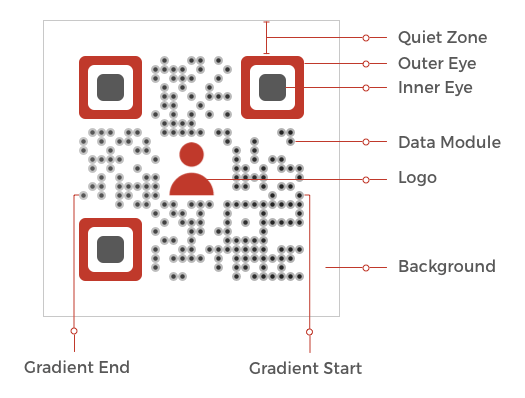
1. Eyes
The eyes are the big squares at the corners of the QR Code. They help scanners recognize the QR Code. You can customize them as per your wish. That means you can change both the color and pattern of the eyes.
2. Data modules
Data modules are small square-shaped elements across the QR Code. They store the information you encode in the QR Code. These modules can be customized by changing their patterns or adding a color to them.
In addition, QR Code API also allows you to add a gradient to the color of data modules.
3. Logo
A logo is situated at the center of the QR Code. It could be an image such as your company or brand’s logo.
4. Error correction
If you add a logo to your QR Code, some data modules near the center will be removed. It is done so to accommodate the logo image.
This removal of data modules introduces an error in the QR Code. So, to ensure QR Code’s high scannability, you need to have an appropriate level of error correction. Error correction ensures that the QR Code can scan well even after the addition of a logo. Here are the different error-correction levels:
- L (7%)
- M (15%)
- Q (25%)
- H (30%)
5. Background Color
As the name suggests, you can add background color to the QR Code. Here, you can add any color you want while ensuring sufficient color contrast between the QR Code and its background. It is important for its scannability.
For example, if the color of the QR Code is black, the background must be white in color and vice-versa.
6. Poster
In addition to the custom-logo design, you can also use the Poster option to customize the QR Code. Here, you can add a background image to your QR Code. Moreover, you can also change the pattern of both the eyes and data modules.
C. How to generate QR Codes via API
Now you know QR Code API can help you generate QR Codes quickly. The next question is—how to create one?
To do that, you’ll need a suitable QR Code API provider. Using QR API for demo purposes, here’s how you can proceed:
1. Go to QR API and sign-up for the free trial
Note that you will get the first 50 API requests for free when you sign-up. Also, you’ll need to enter your card details while signing up.
2. On the page that loads, you’ll see your cycle usage with details such as total allowed requests, requests used, and days remaining. Here, you’ll also see the option Get API Key. Click on Create
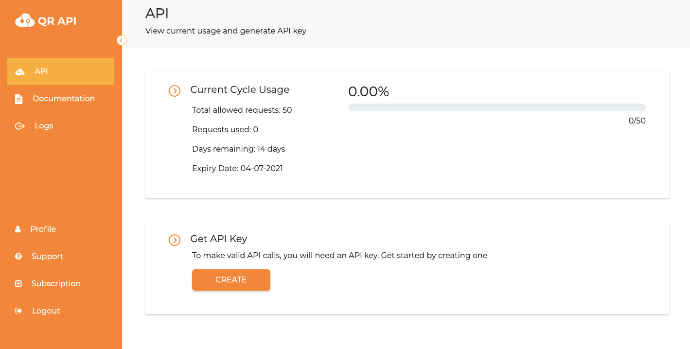
Note that if you choose to sign-up via Google and click on Create, you’ll receive a 6-digit code on your email address. Copy it and paste it into the dialog box. You’ll then be able to see your API Key.
3. Copy the API key and click on Documentation on the dashboard
4. As you scroll down a bit, you’ll see the Authorize button on the right
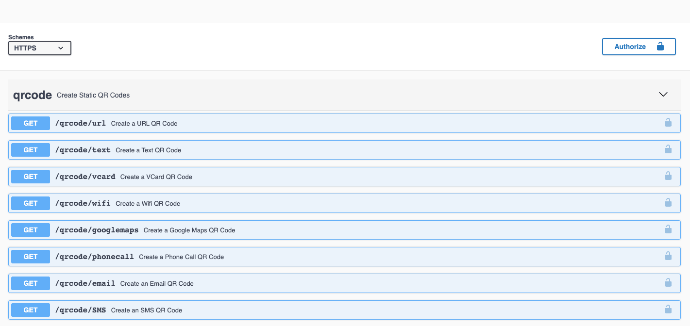
5. Click on the Authorize button. A window will open prompting you to paste the API key in the value box. Once you’ve pasted it, click Authorize
Authorize
6. Select the relevant QR Code category and click on the Test button
Add content
7. Add the content you want to encode in the QR Code. You can also start customizing the QR Code here
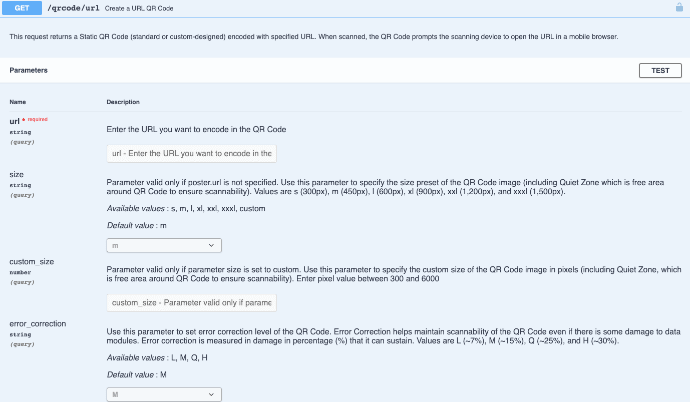
8. Next, you can specify the level of error correction and other design parameters
9. Once you’ve finalized the QR Code content and other parameters, click on Execute

Responses
10. Here, you’ll see various responses such as Curl, Response URL, and Response Body. When you scroll down a little, you’ll also see the image of a QR Code with encoded content
11. Now copy the Response URL and integrate it into your information system or mobile application

That’s it. QR Codes will be generated as the number of response URLs are sent to the API system. It is always advisable to test scan the QR Code before integrating it with your system.
That is all you need to know about how QR Code API can act as a quick QR Code generator. You can now go ahead and generate your own QR Codes in no time.
Generate a QR Code For Your Unique Case
START TODAY!
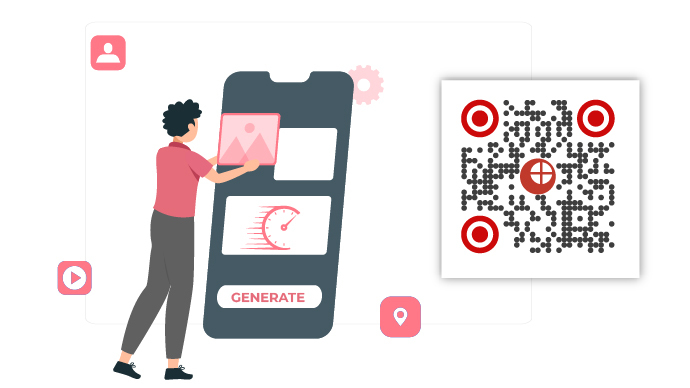
Thanks for providing a informative information on how to quick qr code generate in this extremely useful blog. It was interesting to learn about so many things that are helpful to us all.
Hey Vanni,
We are glad you found the article helpful!